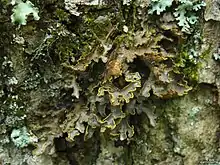Pseudocyphellaria perpetua
Pseudocyphellaria perpetua is a species of corticolous (bark-dwelling), foliose (leafy) cyanolichen in the family Peltigeraceae. It was described as new to science in 2002 by lichenologists Bruce McCune and Jolanta Miądlikowska.[1] It is distinguished from similar species, including some forms of P. crocata, by its yellow medulla and mostly marginal soralia. Other characteristics include its narrow, linear lobes, and its pale lower undersurface.[1] Some molecular phylogenetic analysis suggests that Pseudocyphellaria perpetua and P. crocata are morphotypes of the same phylogenetic species.[2] P. perpetua occurs on both conifer and hardwood trees in oceanic areas of the western North America and in the Russian Far East.[1] It has also been documented as an uncommon species in Nova Scotia (eastern Canada).[3]
| Pseudocyphellaria perpetua | |
|---|---|
 | |
| Scientific classification | |
| Domain: | Eukaryota |
| Kingdom: | Fungi |
| Division: | Ascomycota |
| Class: | Lecanoromycetes |
| Order: | Peltigerales |
| Family: | Peltigeraceae |
| Genus: | Pseudocyphellaria |
| Species: | P. perpetua |
| Binomial name | |
| Pseudocyphellaria perpetua McCune & Miądl. (2002) | |
References
- Miadlikowska, Jolanta; McCune, Bruce; Lutzoni, François (2002). "Pseudocyphellaria perpetua, a new lichen from western North America". The Bryologist. 105 (1): 1–10. doi:10.1639/0007-2745(2002)105[0001:ppanlf]2.0.co;2. JSTOR 3244816. S2CID 33926437.
- Summerfield, Tina C.; Eaton‐Rye, Julian J. (2006). "Pseudocyphellaria crocata, P. neglecta and P. perpetua from the Northern and Southern Hemispheres are a phylogenetic species and share cyanobionts". New Phytologist. 170 (3): 597–607. doi:10.1111/j.1469-8137.2006.01701.x. PMID 16626479.
- Cameron, Robert P.; Richardson, David H.S. (2006). "Occurrence and abundance of epiphytic cyanolichens in protected areas of Nova Scotia, Canada" (PDF). Opuscula Philolichenum. 3: 5–14.